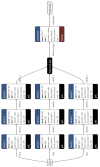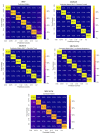Wheel Defect Detection Using a Hybrid Deep Learning Approach
- PMID: 37514543
- PMCID: PMC10383427
- DOI: 10.3390/s23146248
Wheel Defect Detection Using a Hybrid Deep Learning Approach
Abstract
Defective wheels pose a significant challenge in railway transportation, impacting operational performance and safety. Excessive traction and braking forces give rise to deviations from the intended conical tread shape, resulting in amplified vibrations and noise. Moreover, these deviations contribute to the accelerated damage of track components. Detecting wheel defects at an early stage is crucial to ensure safe and comfortable operation, as well as to minimize maintenance costs. However, the presence of various vibrations, such as those induced by the track, traction motors, and other rolling stock subsystems, poses a significant challenge for onboard detection techniques. These vibrations create difficulties in accurately identifying wheel defects in real-time during operational activities, often resulting in false alarms. This research paper aims to address this issue by using a hybrid deep learning-based approach for the accurate detection of various types of wheel defects using accelerometer data. The proposed approach aims to enhance wheel defect detection accuracy while considering onboard techniques' cost-effectiveness and efficiency. A realistic simulation model of the railway wheelset is developed to generate a comprehensive dataset. To generate vibration data in various scenarios, the model is simulated for 20 s under different conditions, including one non-faulty scenario and six faulty scenarios. The simulations are conducted at different speeds and track conditions to capture a wide range of operating conditions. Within each simulation iteration, a total of 200,000 data points are generated, providing a comprehensive dataset for analysis and evaluation. The generated data are then utilized to train and evaluate a hybrid deep learning model, employing a multi-layer perceptron (MLP) as a feature extractor and multiple machine learning models (support vector machine, random forest, decision tree, and k-nearest neighbors) for performance comparison. The results demonstrate that the MLP-RF (multi-layer perceptron with random forest) model achieved an accuracy of 99%, while the MLP-DT (multi-layer perceptron with decision tree) model achieved an accuracy of 98%. These high accuracy values indicate the effectiveness of the models in accurately classifying and predicting the outcomes. The contributions of this research work include the development of a realistic simulation model, the evaluation of sensor layout effectiveness, and the application of deep learning techniques for improved wheel flat detections.
Keywords: MLP; deep learning; false flange; nonlinear dynamics; wheel defects; wheel flats.
Conflict of interest statement
The authors declare no conflict of interest.
Figures







Similar articles
-
A Novel Approach to Railway Track Faults Detection Using Acoustic Analysis.Sensors (Basel). 2021 Sep 16;21(18):6221. doi: 10.3390/s21186221. Sensors (Basel). 2021. PMID: 34577429 Free PMC article.
-
Recent Advances in Wayside Railway Wheel Flat Detection Techniques: A Review.Sensors (Basel). 2023 Apr 12;23(8):3916. doi: 10.3390/s23083916. Sensors (Basel). 2023. PMID: 37112257 Free PMC article. Review.
-
In-Service Detection and Quantification of Railway Wheel Flat by the Reflective Optical Position Sensor.Sensors (Basel). 2020 Sep 2;20(17):4969. doi: 10.3390/s20174969. Sensors (Basel). 2020. PMID: 32887346 Free PMC article.
-
Optimizing neural networks for medical data sets: A case study on neonatal apnea prediction.Artif Intell Med. 2019 Jul;98:59-76. doi: 10.1016/j.artmed.2019.07.008. Epub 2019 Jul 25. Artif Intell Med. 2019. PMID: 31521253
-
A Study on Wheel Member Condition Recognition Using 1D-CNN.Sensors (Basel). 2023 Nov 29;23(23):9501. doi: 10.3390/s23239501. Sensors (Basel). 2023. PMID: 38067874 Free PMC article.
Cited by
-
FaultSeg: A Dataset for Train Wheel Defect Detection.Sci Data. 2025 Feb 20;12(1):309. doi: 10.1038/s41597-025-04557-0. Sci Data. 2025. PMID: 39979297 Free PMC article.
-
MFF-YOLO: An Accurate Model for Detecting Tunnel Defects Based on Multi-Scale Feature Fusion.Sensors (Basel). 2023 Jul 18;23(14):6490. doi: 10.3390/s23146490. Sensors (Basel). 2023. PMID: 37514784 Free PMC article.
References
-
- Krummenacher G., Ong C.S., Koller S., Kobayashi S., Buhmann J.M. Wheel Defect Detection with Machine Learning. IEEE Trans. Intell. Transp. Syst. 2018;19:1176–1187. doi: 10.1109/TITS.2017.2720721. - DOI
-
- Alemi A., Corman F., Lodewijks G. Condition monitoring approaches for the detection of railway wheel defects. Proc. Inst. Mech. Eng. Part F J. Rail Rapid Transit. 2017;231:961–981. doi: 10.1177/0954409716656218. - DOI
-
- Shaikh K., Kalwer I.H., Mal K., Chowdhry B.S. Signal-Based Indirect Wheel Profile Estimation Technique for Solid Axle Railway Wheelset. Mehran Univ. Res. J. Eng. Technol. 2021;40:443–449. doi: 10.22581/muet1982.2102.18. - DOI
-
- Mosleh A., Meixedo A., Ribeiro D., Montenegro P., Calçada R. Early wheel flat detection: An automatic data-driven wavelet-based approach for railways. Veh. Syst. Dyn. 2023;61:1644–1673.
LinkOut - more resources
Full Text Sources

